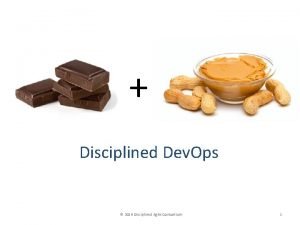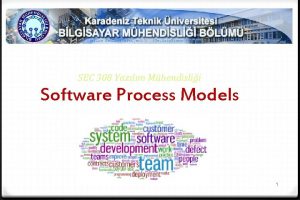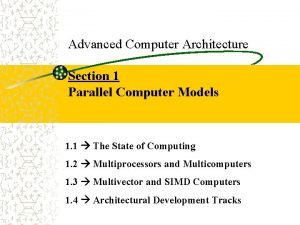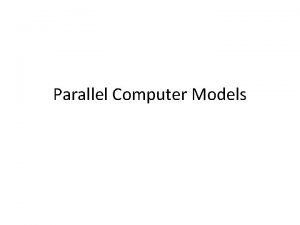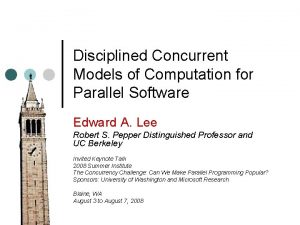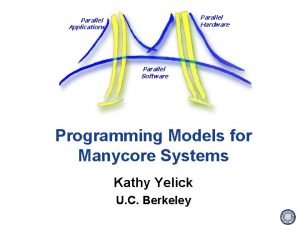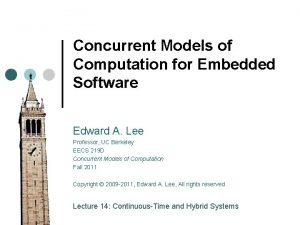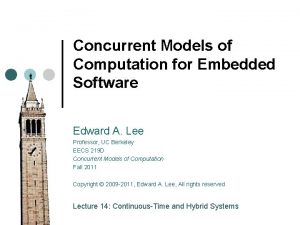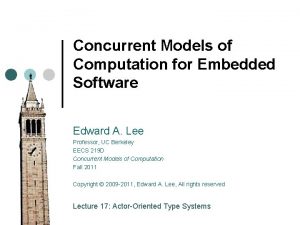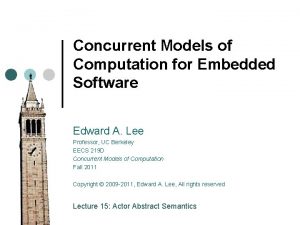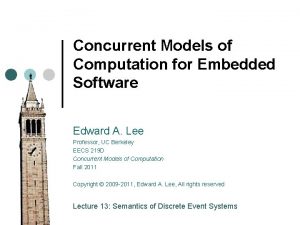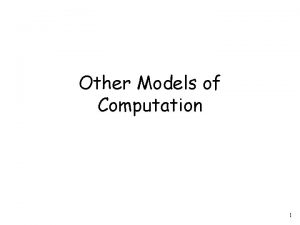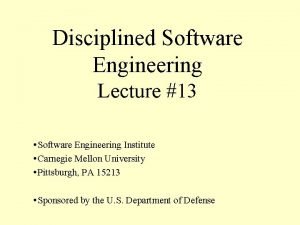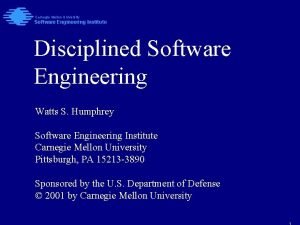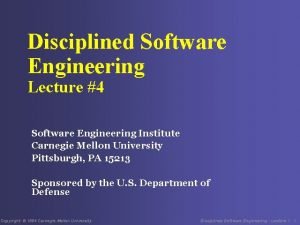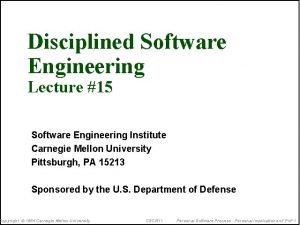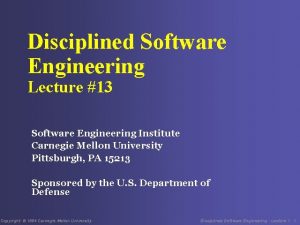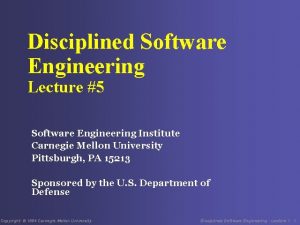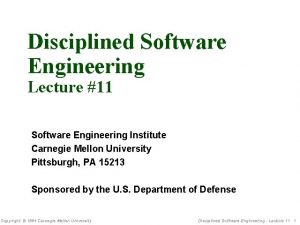Disciplined Concurrent Models of Computation for Parallel Software
















































![Our solution: Parks’ Strategy [Parks 95] This “solves” the undecidable problems: l l Start Our solution: Parks’ Strategy [Parks 95] This “solves” the undecidable problems: l l Start](https://slidetodoc.com/presentation_image_h2/1a0196da99c1a8b74e28b6f70414ffc4/image-49.jpg)








- Slides: 57

Disciplined Concurrent Models of Computation for Parallel Software Edward A. Lee Robert S. Pepper Distinguished Professor and UC Berkeley Invited Keynote Talk 2008 Summer Institute The Concurrency Challenge: Can We Make Parallel Programming Popular? Sponsors: University of Washington and Microsoft Research Blaine, WA August 3 to August 7, 2008

A Tired Debate… ¢ Shared memory l ¢ Threads, semaphores, mutexes, monitors… Message Passing l Synchronous, asynchronous, buffered, … This debate is a red herring! The choice of shared memory vs. message passing should be left up to the architects and compilers, and not up to the programmers. Lee, Berkeley 2

Shared memory is not an acceptable programmer’s model Nontrivial software written with threads, semaphores, and mutexes are incomprehensible to humans. Lee, Berkeley 3

Consider a Simple Example “The Observer pattern defines a one-to-many dependency between a subject object and any number of observer objects so that when the subject object changes state, all its observer objects are notified and updated automatically. ” Design Patterns, Eric Gamma, Richard Helm, Ralph Johnson, John Vlissides (Addison-Wesley Publishing Co. , 1995. ISBN: 0201633612): Lee, Berkeley 4

Observer Pattern in Java public void add. Listener(listener) { my. Listeners. add(listener); } public void set. Value(new. Value) { my. Value = new. Value; for (listener : my. Listeners) { listener. value. Changed(new. Value) } } Thanks to Mark S. Miller for the details of this example. Will this work in a multithreaded context? Lee, Berkeley 5

Observer Pattern With Mutual Exclusion public synchronized void add. Listener(listener) { my. Listeners. add(listener); } public synchronized void set. Value(new. Value) { my. Value = new. Value; for (listener : my. Listeners) { listener. value. Changed(new. Value) } } Javasoft recommends against this. What’s wrong with it? Lee, Berkeley 6

Mutexes are Minefields public synchronized void add. Listener(listener) { my. Listeners. add(listener); } public synchronized void set. Value(new. Value) { my. Value = new. Value; for (listener : my. Listeners) { listener. value. Changed(new. Value) } } value. Changed() may attempt to acquire a lock on some other object and stall. If the holder of that lock calls add. Listener(), deadlock! Lee, Berkeley 7

After years of use without problems, a Ptolemy Project code review found code that was not thread safe. It was fixed in this way. Three days later, a user in Germany reported a deadlock that had not shown up in the test suite. Lee, Berkeley 8

Should have used tools… Tsk, tsk… Should have used static analysis tools to detect the deadlock potential… But detection is only half the battle… How to fix it? Lee, Berkeley 9

Simple Observer Pattern Becomes Not So Simple public synchronized void add. Listener(listener) { my. Listeners. add(listener); } public synchronized void set. Value(new. Value) { while holding lock, make synchronized(this) { copy of listeners to avoid my. Value = new. Value; race conditions listeners = my. Listeners. clone(); notify each listener } outside of synchronized for (listener : listeners) { block to avoid deadlock listener. value. Changed(new. Value) } } This still isn’t right. What’s wrong with it? Lee, Berkeley 10

Simple Observer Pattern: How to Make It Right? public synchronized void add. Listener(listener) { my. Listeners. add(listener); } public synchronized void set. Value(new. Value) { synchronized(this) { my. Value = new. Value; listeners = my. Listeners. clone(); } for (listener : listeners) { listener. value. Changed(new. Value) } Suppose two threads call set. Value(). One of them will set the value last, } leaving that value in the object, but listeners may be notified in the opposite order. The listeners may be alerted to the value changes in the wrong order! Lee, Berkeley 11

Perhaps Concurrency is Just Hard… Sutter and Larus observe: “humans are quickly overwhelmed by concurrency and find it much more difficult to reason about concurrent than sequential code. Even careful people miss possible interleavings among even simple collections of partially ordered operations. ” H. Sutter and J. Larus. Software and the concurrency revolution. ACM Queue, 3(7), 2005. Lee, Berkeley 13

If concurrency were intrinsically hard, we would not function well in the physical world It is not concurrency that is hard… Lee, Berkeley 14

…It is shared memory that is Hard! Threads are sequential processes that share memory. From the perspective of any thread, the entire state of the universe can change between any two atomic actions (itself an ill-defined concept). Imagine if the physical world did that… Lee, Berkeley 15

Concurrent programs using shared memory are incomprehensible because concurrency in the physical world does not work that way. We have no experience! Lee, Berkeley 16

Succinct Problem Statement Threads are wildly nondeterministic. The programmer’s job is to prune away the nondeterminism by imposing constraints on execution order (e. g. , mutexes, transactions) and limiting shared data accesses (e. g. , OO design). Lee, Berkeley 17

We have incrementally improved threads ¢ ¢ ¢ ¢ ¢ Object Oriented programming Coding rules (Acquire locks in the same order…) Libraries (Stapl, Java 5. 0, …) PGAS (UPC, Co-array FORTRAN, Titanium, …) Patterns (Map. Reduce, …) Transactions (Databases, …) Formal verification (Blast, thread checkers, …) Enhanced languages (Split-C, Cilk, Guava, …) Enhanced mechanisms (Promises, futures, …) But is it enough to refine a mechanism with flawed foundations? Lee, Berkeley 18

E. g. : Verification: Thread checkers? Consider what it would take for static analysis tools to detect the out-of-order notification bug in our implementation of the listener pattern… We want to tolerate a race on calls to set. Value() (application nondetermism), but not on notifications to listeners. To specify this for a verifier, we have to have already solved the problem! Lee, Berkeley 19

For a brief optimistic instant, transactions looked like they might save us… “TM is not as easy as it looks (even to explain)” Michael L. Scott, invited keynote, (EC)2 Workshop, Princeton, NJ, July 2008 Lee, Berkeley 20

Do we have a sound foundation for concurrent programming? If the foundation is bad, then we either tolerate brittle designs that are difficult to make work, or we have to rebuild from the foundations. Note that this whole enterprise is held up by threads Lee, Berkeley 21

So, the answer must be message passing, right? Not quite… More discipline is needed that what is provided by today’s message passing libraries. Lee, Berkeley 22

One approach: Rethinking software components for concurrency The established: Object-oriented: class name What flows through an object is sequential control data methods call return Things happen to objects The alternative: Actor oriented: actor name data (state) parameters ports Input data Actors make things happen What flows through an object is evolving data Output data Lee, Berkeley 23

Examples of Actor-Oriented Systems ¢ ¢ ¢ ¢ Unix pipes Dataflow systems CORBA event service (distributed push-pull) ROOM and UML-2 (dataflow, Rational, IBM) VHDL, Verilog (discrete events, Cadence, Synopsys, . . . ) Lab. VIEW (structured dataflow, National Instruments) Modelica (continuous-time, constraint-based, Linkoping) OPNET (discrete events, Opnet Technologies) SDL (process networks) Occam (rendezvous) Simulink (Continuous-time, The Math. Works) SPW (synchronous dataflow, Cadence, Co. Ware) … The semantics of these differ considerably, but all provide more understandable ways of expressing concurrency. Lee, Berkeley 24

Recall the Observer Pattern “The Observer pattern defines a one-to-many dependency between a subject object and any number of observer objects so that when the subject object changes state, all its observer objects are notified and updated automatically. ” Lee, Berkeley 25

Observer Pattern using an Actor-Oriented Language with Rendezvous Semantics Each actor is a process, communication is via rendezvous, and the Merge explicitly represents nondeterministic multi-way rendezvous. This is realized here in a coordination language with a visual syntax. Lee, Berkeley 26

Now that we’ve made a trivial design pattern trivial, we can work on more interesting aspects of the design. E. g. , suppose we don’t care how long notification of the observer is deferred, as long as the observer is notified of all changes in the right order? Lee, Berkeley 27

Observer Pattern using an Actor-Oriented Language with Kahn Semantics (Extended with Nondeterministic Merge) Each actor is a process, communication is via streams, and the Nondeterministic. Merge explicitly merges streams nondeterministically. Again a coordination language with a visual syntax. Lee, Berkeley 28

Suppose further that we want to explicitly specify the timing? Lee, Berkeley 29

Observer Pattern using an Actor-Oriented Language with Discrete Event Semantics Messages have a (semantic) time, and actors react to messages chronologically. Merge now becomes deterministic. Again a coordination language with a visual syntax. Lee, Berkeley 30

Isn’t this just message passing? Each of these realizations of the listener pattern can be implemented with a message passing library (or with threads, for that matter). But a message passing library allows too much flexibility to yield comprehensible designs. Its capabilities need to be used judiciously… Lee, Berkeley 31

Consider for example Determinism Most programs specify a particular computation, expecting the same input to yield the same output. Occasionally, programs require nondeterminism, where the input/output relation is not a function. Multiple outputs are possible for the same input. Regrettably, without considerable sophistication, message passing libraries often yield inadvertently nondeterminate programs. Lee, Berkeley 32

Consider Streams ¢ In 1974, Gilles Kahn showed that prefix-monotonic functions on streams composed deterministically. ¢ In 1977, Kahn and Mac. Queen showed that prefix monotonic functions could be implemented with blocking reads. ¢ Unix pipes use such blocking reads, and achieve determinate composition, but have limited expressiveness. ¢ Message passing libraries, however, are more flexible, and unless the programmer has studied Kahn, he is likely to mess up… Lee, Berkeley 33

A disciplined use of streams follows Kahn. Mac. Queen semantics, except where explicitly requested by the programmer. nonblocking reads, provided only in a library component blocking reads, provided for all userdefined components. This becomes a disciplined model of computation, trivially easy for the programmer to understand, with excellent analogies in the physical world. Lee, Berkeley 34

A few disciplined concurrent models of computation ¢ ¢ ¢ Kahn process networks Dataflow Synchronous/reactive systems Rendezvous Discrete-events … Each of these has many variants with sometimes subtle differences due to differing constraints imposed on the programmer. Lee, Berkeley 35

A few variants of dataflow, for example ¢ ¢ ¢ ¢ Dynamic dataflow [Arvind, 1981] Structured dataflow [Matwin & Pietrzykowski 1985] K-bounded loops [Culler, 1986] Synchronous dataflow [Lee & Messerschmitt, 1986] Structured dataflow and Lab. VIEW [Kodosky, 1986] PGM: Processing Graph Method [Kaplan, 1987] Synchronous languages [Lustre, Signal, 1980’s] Well-behaved dataflow [Gao, 1992] Boolean dataflow [Buck and Lee, 1993] Multidimensional SDF [Lee, 1993] Cyclo-static dataflow [Lauwereins, 1994] Integer dataflow [Buck, 1994] Bounded dynamic dataflow [Lee and Parks, 1995] Heterochronous dataflow [Girault, Lee, & Lee, 1997] … Lee, Berkeley 36

Isn’t this just message passing again? Dataflow models can be built with message passing libraries (and with threads). But should the programmer be asked to handle the considerable subtleties? Few programmers will get it right… Lee, Berkeley 37

Some Subtleties ¢ ¢ ¢ ¢ Termination, deadlock, and livelock (halting) Bounding the buffers. Fairness Parallelism Data structures and shared data Determinism Syntax Lee, Berkeley 38

Dennis-Style Dataflow Communication between actors is via potentially unbounded streams of tokens. Each actor has firing rules, which specify how availability of input tokens enables a computation. Constraints on the firing rules can yield very nice properties. Firing rules: the number of tokens required to fire an actor. A signal or stream is a (potentially infinite) sequence of communicated data tokens. . Without these nice properties, scheduling policy is a very subtle question. Lee, Berkeley 39

Question 1: Is “Fair” Scheduling a Good Idea? In the following model, what happens if every actor is given an equal opportunity to run? Lee, Berkeley 40

Question 2: Is “Data-Driven” Execution a Good Idea? In the following model, if actors are allowed to run when they have input data on connected inputs, what will happen? Lee, Berkeley 41

Question 3: When are Outputs Required? Is the execution shown for the following model the “right” execution? Lee, Berkeley 42

Question 4: Is “Demand-Driven” Execution a Good Idea? In the following model, if actors are allowed to run when another actor requires their outputs, what will happen? Lee, Berkeley 43

Question 5: What is the “Correct” Execution of This Program? Lee, Berkeley 44

Question 6: What is the Correct Behavior of this Program? Lee, Berkeley 45

Naïve Schedulers Fail ¢ ¢ Fair Demand driven Data driven Most mixtures of demand data driven If programmers are building such programs with message passing libraries or threads, what will keep them from repeating these mistakes that have been made by top experts in the field? Lee, Berkeley 46

These problems have been solved! Let’s not make programmers re-solve them for every program. Library of directors Program using actor-oriented components and a PN Mo. C In Ptolemy II, a programmer specifies a director, which provides much more structure than message-passing or thread library. It provides a concurrent model of computation (Mo. C). Lee, Berkeley 47

The PN Director solves the above problems by implementing a “useful execution” Define a correct execution to be any execution for which after any finite time every signal is a prefix of the signal given by the (Kahn) least-fixed -point semantics. Define a useful execution to be a correct execution that satisfies the following criteria: 1. 2. For every non-terminating model, after any finite time, a useful execution will extend at least one stream in finite (additional) time. If a correct execution satisfying criterion (1) exists that executes with bounded buffers, then a useful execution will execute with bounded Lee, Berkeley 48

Programmers should not have to figure out how to solve these problems! Undecidability and Turing Completeness [Buck 93] Given the following four actors and Boolean streams, you can construct a universal Turing machine: Hence, the following questions are undecidable: l l Will a model deadlock (terminate)? Can a model be executed with bounded buffers? Lee, Berkeley 49
![Our solution Parks Strategy Parks 95 This solves the undecidable problems l l Start Our solution: Parks’ Strategy [Parks 95] This “solves” the undecidable problems: l l Start](https://slidetodoc.com/presentation_image_h2/1a0196da99c1a8b74e28b6f70414ffc4/image-49.jpg)
Our solution: Parks’ Strategy [Parks 95] This “solves” the undecidable problems: l l Start with an arbitrary bound on the capacity of all buffers. Execute as much as possible. If deadlock occurs and at least one actor is blocked on a write, increase the capacity of at least one buffer to unblock at least one write. Continue executing, repeatedly checking for deadlock. This delivers a useful execution (possibly taking infinite time to tell you whether a model deadlocks and how much buffer memory it requires). Lee, Berkeley 50

More constrained Mo. Cs yield better to static analysis. E. g. Synchronous Dataflow (SDF) [Lee & Messerschmitt, 87] Limit the expressiveness by constraining the number of tokens consumed and produced on each firing to be constant. Eliminates: Lee, Berkeley 51

Balance Equations Let q. A, q. B be the number of firings of actors A and B. Let p. C, c. C be the number of token produced and consumed on a connection C. Then the system is in balance if for all connections C q. A p. C = q. B c. C where A produces tokens on C and B consumes them. Lee, Berkeley 52

Decidable Models For SDF, boundedness and deadlock are decidable. Moreover, parallel scheduling can be done statically, and useful optimization problems can be solved. See for example: 1. 2. 3. Ha and Lee, "Compile-Time Scheduling and Assignment of Dataflow Program Graphs with Data. Dependent Iteration, " IEEE Trans. on Computers, November, 1991. Sih and Lee, "Declustering: A New Multiprocessor Scheduling Technique, " IEEE Trans. on Parallel and Distributed Systems, June 1993. Sih and Lee, "A Compile-Time Scheduling Heuristic for Interconnection-Constrained Heterogeneous Processor Architectures, " IEEE Trans. on Parallel and Distributed Systems, February 1993. Lee, Berkeley 56

Although this makes scheduling decidable, complex optimization problems remain. Programmers should not have to solve these! Optimization criteria that might be applied: l Minimize buffer sizes. l Minimize the number of actor activations. l Minimize the size of the representation of the schedule (code size). l Maximize throughput. l Minimize latency. See Bhattacharyya, Murthy, and Lee, Software Synthesis from Dataflow Graphs, Kluwer Academic Press, 1996. Lee, Berkeley 58

Example: Minimum Buffer Schedule for a 6 -Actor Dataflow Model ABABCABCDEAFFFFFBABCABCABABCDE AFFFFFBCABABCABCABABCDEAFFFFFBCABABCABC DEAFFFFFBABCABCABCDEAFFFFFBABCABCA BABCDEAFFFFFBCABABCABCABABCDEAFFFFFEBCA FFFFFBABCABCDEAFFFFFBABCABCABCDEAF FFFFBABCABCABABCDEAFFFFFBCABABCABCABABC DEAFFFFFBCABABCABCDEAFFFFFBABCABCABABCA BCDEAFFFFFBABCABCABABCDEAFFFFFEBCAFFFFFB ABCABCABABCDEAFFFFFBCABABCABCDEAFFFFFBA BCABCABCDEAFFFFFBABCABCABABCDEAFFF FFBCABABCABCABABCDEAFFFFFBCABABCABCDEAF FFFFBABCABCABCDEAFFFFFEBAFFFFFBCABC ABABCDEAFFFFFBCABABCABCABABCDEAFFFFFBCA BABCABCDEAFFFFFBABCABCABCDEAFFFFFB ABCABCABABCDEAFFFFFBCABABCABCABABCDEAF FFFFBCABABCABCDEFFFFF Source: Shuvra Bhattacharyya Lee, Berkeley 59

SDF, by itself, is too restrictive. Extensions improve expressiveness. ¢ ¢ ¢ ¢ Heterochronous Dataflow [Girault, Lee, and Lee, 97] Structured Dataflow [Kodosky 86, Thies et al. 02] (the other) Synchronous Dataflow [Halbwachs et al. 91] Cyclostatic Dataflow [Lauwereins 94] Multidimensional SDF [Lee & Murthy 96] Parameterized Dataflow [Bhattacharya et al. 00] Teleport Messages [Thies et al. 05] All of these remain decidable And there are many other non-dataflow actor-oriented Mo. Cs to bring into the mix! Lee, Berkeley 60

Work to be done ¢ ¢ Develop language support for actor-oriented design (like what C++ did for object-oriented design). Generalize parallel schedulers to work for more expressive Mo. Cs. Support mixing Mo. Cs to enable to exploiting static analysis where possible (this is partially done in Ptolemy II, but much work is left). Develop and support design patterns that expose parallelism in actor-oriented designs (e. g. gatherscatter, Map. Reduce, etc. ) Lee, Berkeley 61

Conclusion: Disciplined Concurrent Models of Computation ¢ Do not use nondeterministic programming models to accomplish deterministic ends. ¢ Use concurrency models that have analogies in the physical world (actors, not threads). ¢ Provide these in the form of models of computation (Mo. Cs) with well-developed semantics and tools. ¢ Use specialized Mo. Cs to exploit semantic properties (avoid excess generality). ¢ Leave the choice of shared memory or message passing to the compiler. Lee, Berkeley 62
 Parallel processing vs concurrent processing
Parallel processing vs concurrent processing Intellectually disciplined
Intellectually disciplined Disciplined agile consortium
Disciplined agile consortium Disciplined agile consortium
Disciplined agile consortium Disciplined agile delivery
Disciplined agile delivery Superlative for tasty
Superlative for tasty Gardner's five minds
Gardner's five minds Disciplined agile delivery roles
Disciplined agile delivery roles What is disciplined
What is disciplined What is concurrent model in software engineering
What is concurrent model in software engineering Modals and semi modals
Modals and semi modals Parallel computer models
Parallel computer models One crore in number
One crore in number Kontinuitetshantering i praktiken
Kontinuitetshantering i praktiken Typiska novell drag
Typiska novell drag Tack för att ni lyssnade bild
Tack för att ni lyssnade bild Vad står k.r.å.k.a.n för
Vad står k.r.å.k.a.n för Varför kallas perioden 1918-1939 för mellankrigstiden?
Varför kallas perioden 1918-1939 för mellankrigstiden? En lathund för arbete med kontinuitetshantering
En lathund för arbete med kontinuitetshantering Underlag för särskild löneskatt på pensionskostnader
Underlag för särskild löneskatt på pensionskostnader Tidbok
Tidbok Sura för anatom
Sura för anatom Vad är densitet
Vad är densitet Datorkunskap för nybörjare
Datorkunskap för nybörjare Stig kerman
Stig kerman Att skriva debattartikel
Att skriva debattartikel För och nackdelar med firo
För och nackdelar med firo Nyckelkompetenser för livslångt lärande
Nyckelkompetenser för livslångt lärande Påbyggnader för flakfordon
Påbyggnader för flakfordon Kraft per area
Kraft per area Offentlig förvaltning
Offentlig förvaltning I gullregnens månad
I gullregnens månad Presentera för publik crossboss
Presentera för publik crossboss Argument för teckenspråk som minoritetsspråk
Argument för teckenspråk som minoritetsspråk Vem räknas som jude
Vem räknas som jude Treserva lathund
Treserva lathund Mjälthilus
Mjälthilus Bästa kameran för astrofoto
Bästa kameran för astrofoto Centrum för kunskap och säkerhet
Centrum för kunskap och säkerhet Verifikationsplan
Verifikationsplan Mat för unga idrottare
Mat för unga idrottare Verktyg för automatisering av utbetalningar
Verktyg för automatisering av utbetalningar Rutin för avvikelsehantering
Rutin för avvikelsehantering Smärtskolan kunskap för livet
Smärtskolan kunskap för livet Ministerstyre för och nackdelar
Ministerstyre för och nackdelar Tack för att ni har lyssnat
Tack för att ni har lyssnat Vad är referatmarkeringar
Vad är referatmarkeringar Redogör för vad psykologi är
Redogör för vad psykologi är Stål för stötfångarsystem
Stål för stötfångarsystem Atmosfr
Atmosfr Borra hål för knoppar
Borra hål för knoppar Vilken grundregel finns det för tronföljden i sverige?
Vilken grundregel finns det för tronföljden i sverige? Formel gruplar
Formel gruplar Tack för att ni har lyssnat
Tack för att ni har lyssnat Steg för steg rita
Steg för steg rita Ledningssystem för verksamhetsinformation
Ledningssystem för verksamhetsinformation Tobinskatten för och nackdelar
Tobinskatten för och nackdelar Blomman för dagen drog
Blomman för dagen drog



